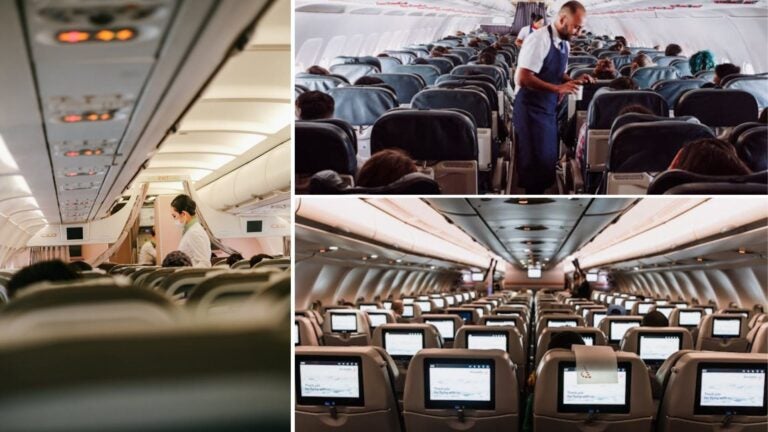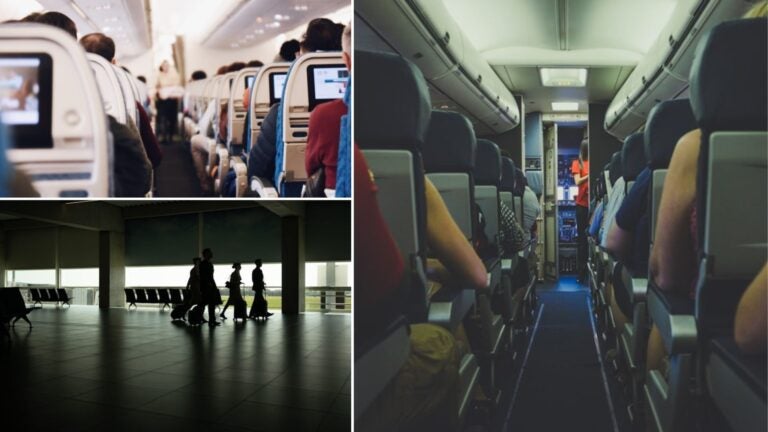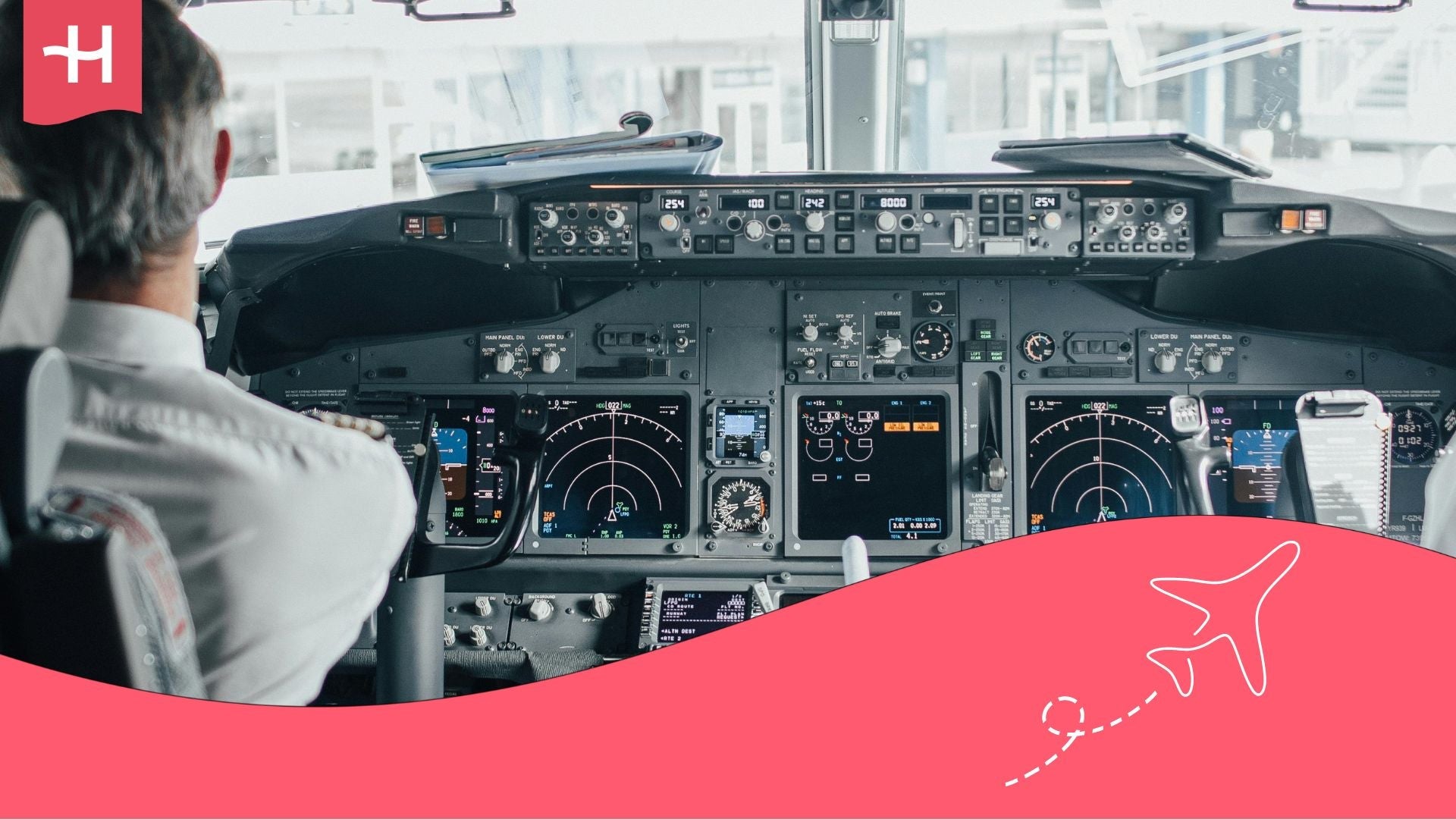A flight attendant’s everyday life: Behind the scenes
Understanding what life is like for a flight attendant will help you decide if it's the right career for you. Keep reading!
If you’ve ever wondered what a flight attendant’s life is really like, the answer is just as fascinating as it is challenging. Behind the perfectly pressed uniform, the warm smiles, and the nonstop travel, there’s a daily routine that blends discipline, a true passion for service, and an impressive ability to adapt.
Being a flight attendant is more than working in the sky. It means dealing with changing schedules, new destinations every week, and a personal life that plays out in airports and hotel rooms. It is a demanding job, but it gives you unforgettable experiences, lasting friendships, and a view of the world that very few careers can offer.
In this guide, we walk you through what a flight attendant’s daily life is really like, from getting ready before a flight to what happens off the clock, so you can decide whether this career truly fits you.
What is life like working as a flight attendant?
If you’ve already put together your flight attendant resume and taken a good look at the pros and cons of the job, getting a sense of what the lifestyle is really like will help you get ready for what comes next.
What many people don’t realize is that a flight attendant’s day begins well before passengers even show up at the gate. And the job itself is so much more than handing out drinks, giving safety demos, and greeting everyone with a smile. That is the side travelers usually see, but there is a lot more going on behind the scenes.
No two days are the same, yet the job requires structure, with punctuality and preparation always essential. There is no fixed routine because schedules change with each destination, flight type, and airline plan. That is why anyone hoping to become a flight attendant needs to be highly adaptable.
Here is a description of the tasks and processes before, during, and after the flight, key moments for understanding what life is like for a flight attendant.
Before the flight
The day kicks off several hours before takeoff. Crew members usually arrive an hour and a half to two hours early for the briefing, a meeting where the captain and lead flight attendant go over key details such as the weather, flight duration, any special procedures, the number of passengers, and assigned roles.
After the briefing, each flight attendant checks the emergency equipment, first aid kits, life vests, and all onboard safety systems. They also make sure that all service supplies, like meals, drinks, and comfort items, are fully stocked.
During the flight
Once passengers start boarding, one of the busiest parts of the job begins. Flight attendants greet everyone, help with luggage, and make sure all passengers are seated safely with their seat belts fastened.
Flight attendants stay seated during takeoff and landing for safety, but once in the air, their work doesn’t stop. They assist passengers, serve meals and drinks, answer questions, and above all, ensure everyone’s safety and comfort throughout the flight.
On long-haul flights, flight attendants can be on duty for eight to twelve hours, with breaks scheduled depending on the length of the trip. Shorter or regional flights involve shorter hours, but often include several flights in a single day.

After the flight
After landing, the crew does a final check of the aircraft, makes sure no passengers leave behind their belongings, and completes service reports. Depending on the schedule, they may return to their home base or stay at a hotel to rest before the next flight.
Layovers often last between 12 and 24 hours, giving crew members time to rest, explore the city, or get ready for the next flight.
Schedules and work pace
One of the biggest challenges of being a flight attendant is getting used to constantly changing schedules and a fast-paced lifestyle. The job does not follow a typical Monday to Friday routine. Early mornings, weekends, and holidays are all part of the mix, and the schedule changes every month. For those who thrive on variety, it can be exciting, but for people who like structure, it can take some time to adjust.
Flight attendants typically log between 70 and 90 hours of flight time each month, but when you include prep, layovers, and travel, total work hours can easily exceed 110 or 120. Succeeding in this role requires strong organization, good health, and the ability to adjust to changing schedules, especially on international flights with different time zones.
Even so, many flight attendants agree that despite the fatigue, the rewards of each flight make it all worthwhile. No two days are the same, and it is that variety that makes this job so exciting.
What is the life of a flight attendant like during free time?
Although the flight schedule is demanding, flight attendants also get time to rest between trips. Free periods vary depending on the airline and route, but after several days of work, they usually have what are called “base days” or scheduled rest days, which are essential for recharging both physically and mentally.
Rest and recovery
After a long flight, rest comes first. The body needs to recover from time changes, cabin pressure, and overall fatigue. Many flight attendants have their own ways to recharge, whether it’s sleeping in a darkened room, staying hydrated, doing some yoga, or just completely disconnecting for a while.
Rest doesn’t always happen at home. Sometimes it comes in a layover hotel, in a different city, or even on another continent. That’s why learning to sleep anywhere and at any time becomes almost a professional skill.
Time for study or training
Outside of work, many flight attendants use their free time to keep learning. Some study languages, while others take courses in tourism, protocol, public relations, or even pursue a university degree.
Although the irregular work schedule can make following a traditional academic path challenging, online courses make it much easier to balance both. Airlines also often provide internal training and refresher programs, allowing flight attendants to keep learning while still on the job.
Personal life and recreational activities
When we think about a flight attendant’s life, it’s easy to picture the travel and time in the air, but there’s also their personal life behind the uniform. Striking a balance between work and personal life is one of the biggest challenges of being a flight attendant.
Days off are a chance to treasure time with family and friends. It is not always easy to match the schedules of people with a regular routine, but most flight attendants learn to make the most of simple pleasures, sharing a meal at home, catching up over a video call, or enjoying a few hours outside before the next trip.
Some use their free time to travel for fun, visit places they discovered on the job, or pursue hobbies like photography, writing, or sports. In a way, the adventurous spirit that drew them to flying stays with them even on the ground.
No matter the airline or the route, the secret is finding balance. Life as a flight attendant blends long, tiring days with full rest, early mornings with exploring new cities. And that is where the magic lies, living each day as it comes with the freedom of having the sky as your office.

What does a flight attendant do during vacations and days off?
Vacations are a whole different story for flight attendants. Unlike many other jobs, they cannot always take time off at the same time as family or friends, but they learn to make the most of the time they do get.
Vacations are planned months in advance and depend on seniority at the airline as well as the flight schedule. In most cases, days off are assigned by shifts or through a priority-based selection system. This means that the more experienced flight attendants usually have greater flexibility in choosing when to rest or travel.
During their time off, many flight attendants head home to reconnect with family, especially if they live far away. Others take the chance to travel for fun, exploring places they only passed through on the job. Even after spending so much of the year in the air, their passion for travel does not fade, it just slows down a bit.
Some flight attendants use their vacations to take courses, improve their language skills, or enjoy hobbies they cannot always fit into their busy schedules. Pilates, photography, cooking, or volunteering are common ways for crew members to unwind and take a break from the fast pace of life in the air.
Regular days off usually range from eight to twelve per month, depending on the airline. They can come in a row or be spread out, and are used both to recharge and to take care of errands, attend training, or simply get a break from the airport environment.
In the end, rest periods are more than just downtime. They are essential for recharging both body and mind. Making the most of these moments with intention and calm is a key part of living a healthy life as a flight attendant.

What is the life of a flight attendant like in terms of friendships and family relationships?
Another common question about a flight attendant’s life is how they manage personal relationships. How do they find time for family? How do they keep friendships strong with such an unpredictable schedule? The truth is that, while it is not always easy, most find a way to make it work.
Flight attendants often spend many days away from home, especially those on international routes. Time apart can last from a few days to over a week, depending on the destinations and layovers. That makes family time especially precious, and reunions are often celebrated with extra joy.
Many flight attendants plan their personal calendars in advance to coordinate family time or vacations, and technology plays a big role. Video calls, messaging, and social media help bridge the distance and stay connected, even when they are in a different time zone.
When it comes to friendships, working in aviation creates unique bonds. Spending so much time together on flights, in hotels, and during long waits at airports often forms strong connections with fellow crew members, who can become like a second family. It is common for groups of flight attendants to reconnect on different routes or stay in touch regularly, even if they work for different airlines.
Friendships outside of work can be challenging because of irregular schedules. It is not always easy to line up with friends who have a typical routine, but many flight attendants learn to focus on making the time they do have meaningful. The trick is to stay connected, be flexible, and enjoy every moment on the ground.
Ultimately, a flight attendant’s family and social life takes planning, flexibility, and a supportive circle that understands the demands of the job. It is not a conventional lifestyle, but it is full of reunions, new friendships, and experiences that strengthen bonds with every flight.
How can you stay connected as a flight attendant?
In a job where destinations change every week and time zones rarely match those at home, staying connected is essential. For a flight attendant, having reliable internet means being able to talk with family between layovers, coordinate schedules, check itineraries, and share moments with loved ones far away. In other words, it is the way to stay in touch with life on the ground.
In this regard, Holafly Plans has become one of the most convenient solutions for flight attendants. Its global eSIM allows them to stay online in over 170 countries without swapping physical SIM cards or paying high roaming fees. By simply scanning a QR code, the connection activates automatically, keeping them connected at every destination, from an airport in Europe to a hotel in Asia or the Americas.
Put simply, Holafly’s monthly plans are ideal for those who live on the go. For a flight attendant, who spends so much time in the air, staying connected is what makes finding balance possible.
Important: If you are a frequent traveler and want to stay connected without worrying about expensive roaming or looking for a new SIM at every destination, Holafly’s subscription plans are for you. With a single eSIM, enjoy internet in more than 170 countries for a fixed price and no surprises on your bill. Travel without limits and connect easily and securely! 🚀🌍

Frequently asked questions about the life of a flight attendant
English is essential. It is the official language of aviation and is used in all international procedures. Most airlines require an upper-intermediate level or higher. Knowing additional languages, such as French, Portuguese, or Arabic, is a big advantage, as it helps communicate with passengers and can open doors to opportunities with foreign airlines.
It depends on the airline and the type of routes. On average, flight attendants log between 70 and 90 flight hours per month, though total duty time can reach 110 to 120 hours. Schedules change constantly, with night flights one week and daytime flights the next.
Airlines usually assign a home base, which may be in a different country from where the crew member is originally from. In some cases, the company provides temporary housing until they settle in. Many flight attendants share an apartment with colleagues, which helps cut costs and build connections during the adjustment period.
Time at home depends on the type of route. Those on domestic flights often return the same day or the next, while international crews can be away for several days. That’s why days off and vacations are planned in advance, so they can make the most of family time.
To work as a flight attendant, you need an official license, which is earned through civil aviation schools approved by the country’s aviation authority. Training covers topics such as air safety, first aid, passenger service, and survival skills, along with hands-on practice in simulators. The program usually takes six months to a year, depending on the country.
Not completely. The schedule changes every month and destinations are constantly rotating. Still, many flight attendants find ways to create their own routine with exercise, healthy meals, and rest, helping them stay balanced despite the demands of life in the air.





 Language
Language 


















 No results found
No results found






